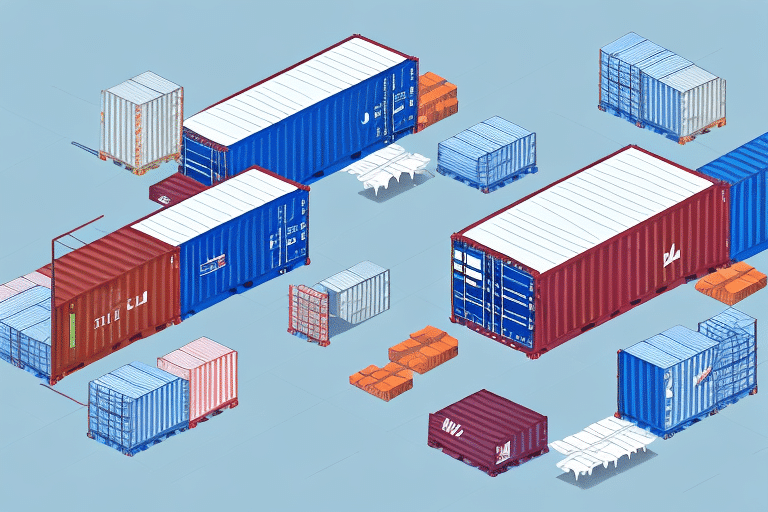Understanding Floor Loading and Pallet Loading
In the shipping and logistics industry, two prevalent methods for loading goods are floor loading and pallet loading. Floor loading involves placing goods directly onto the floor of a shipping container or trailer without any intermediary support. On the other hand, pallet loading involves stacking goods onto wooden or plastic pallets, which are then secured within the container or trailer. Each method has its unique advantages and is suited to different types of shipments.
Pros and Cons of Floor Loaded Shipping Solutions
Advantages of Floor Loading
- Cost-Effective: Floor loading can reduce shipping costs as it eliminates the need for pallets and other load-bearing equipment.
- Flexibility: This method is ideal for irregularly shaped or oversized items that may not fit well on standard pallets.
- Environmental Benefits: By avoiding the use of pallets, floor loading generates less waste, contributing to a smaller carbon footprint.
Disadvantages of Floor Loading
- Security Risks: Without pallets, goods may shift or slide during transit, increasing the risk of damage or loss.
- Time-Consuming: Loading and unloading individual items can be more time-consuming compared to palletized shipments.
- Limited Suitability: Not ideal for fragile or moisture-sensitive items that require additional protection.
Pros and Cons of Pallet Loaded Shipping Solutions
Advantages of Pallet Loading
- Enhanced Security: Pallets provide a stable base, reducing the movement of goods and minimizing damage during transit.
- Efficiency: Pallets can be easily handled with forklifts or pallet jacks, speeding up the loading and unloading process.
- Space Optimization: Stacking pallets efficiently utilizes container space, allowing for larger quantities of goods to be shipped.
- Reusability: Pallets can be reused multiple times, offering cost savings and reducing waste.
Disadvantages of Pallet Loading
- Higher Costs: Initial investment in pallets and load-bearing equipment can increase shipping costs, especially for smaller shipments.
- Less Flexibility: Pallets have fixed dimensions, making it challenging to accommodate irregularly shaped or oversized items.
- Additional Handling: The process of palletizing and depalletizing adds extra steps to the shipping workflow.
Cost and Environmental Impact
Cost Analysis
The choice between floor loading and pallet loading can significantly impact shipping costs. According to the American Business Online Report, pallet loading typically incurs higher upfront costs due to the purchase of pallets and related equipment. However, for large shipments, pallet loading can be more cost-effective in the long run due to reduced handling times and the reusability of pallets.
Environmental Impact
Pallet loading tends to have a higher environmental footprint due to the use of materials like wood or plastic pallets. Conversely, floor loading reduces material usage, making it a more sustainable option. A study by the Environmental Protection Agency highlights that minimizing packaging materials and optimizing space can lead to lower carbon emissions in the shipping process.
Safety Considerations
Both loading methods come with their own safety challenges. Floor loading requires meticulous securing of goods to prevent shifting, which can lead to accidents during transit. Pallet loading, while generally more secure, requires proper handling to avoid injuries related to lifting and moving heavy pallets. Adhering to safety guidelines set by organizations such as the Occupational Safety and Health Administration is crucial for both methods.
When to Use Each Loading Method
When to Use Floor Loading
- For smaller or irregularly shaped shipments.
- When shipping fragile or delicate items that require flat placement.
- To maximize container space for specific types of goods.
- When minimizing material usage is a priority.
When to Use Pallet Loading
- For larger shipments that benefit from stacking and efficient space utilization.
- When goods require enhanced security and stability during transit.
- For operations that utilize forklifts or pallet jacks for handling.
- When the reusability of pallets can lead to cost savings over time.
Best Practices and Future Trends
Best Practices
- Assess Shipment Requirements: Evaluate the size, weight, and fragility of goods to determine the most suitable loading method.
- Optimize Container Space: Whether floor loading or pallet loading, ensure that container space is utilized efficiently to minimize costs.
- Implement Proper Securing Techniques: Use appropriate straps, ties, and other securing methods to prevent movement of goods.
- Regularly Train Staff: Ensure that personnel are trained in safe loading and unloading practices to reduce the risk of accidents.
Future Developments
The freight transportation industry is continuously evolving with advancements in technology and materials. Innovations such as automated palletizing systems and eco-friendly pallet materials are making pallet loading more efficient and sustainable. Additionally, the integration of IoT (Internet of Things) devices for real-time tracking and monitoring can enhance the security and management of both loading methods. Keeping abreast of these developments is essential for businesses looking to optimize their shipping operations.
Real-World Examples: Successful Implementation of Both Methods
Companies across various industries successfully employ both floor loading and pallet loading based on their specific needs. For instance, a e-commerce giant may utilize pallet loading for bulk shipments to distribution centers, ensuring efficiency and security. Conversely, a boutique apparel retailer might prefer floor loading for unique or delicate items to maintain product integrity during transit. These examples illustrate the importance of selecting the appropriate loading method to align with business objectives and shipment characteristics.
Key Takeaways: Which Method is Right for Your Business?
- There is no one-size-fits-all solution; the best loading method depends on specific shipment needs.
- Consider factors such as cost, environmental impact, safety, and the nature of the goods being shipped.
- Consult with logistics experts to determine the most efficient and effective shipping strategy.
- Stay informed about industry trends and advancements to continuously optimize your shipping processes.
By carefully evaluating these factors and implementing best practices, businesses can make informed decisions that enhance their shipping efficiency, reduce costs, and minimize environmental impact.






















